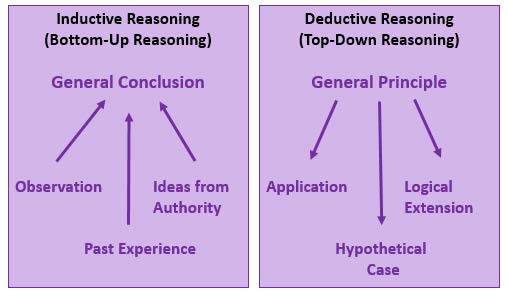Cognitive Development in Adolescence
Diana Lang; Nick Cone; Martha Lally; Suzanne Valentine-French; Tera Jones; and Lumen Learning
Cognitive changes during adolescence include a shift from concrete to more abstract and complex thinking. Such changes are fostered by improvements during early adolescence in attention, memory, processing speed, and metacognition (ability to think about thinking and therefore make better use of strategies like mnemonic devices that can improve thinking). As explained before, early in adolescence, changes in the brain’s limbic system contribute to increases in adolescents’ sensation-seeking and reward motivation. Later in adolescence, the brain’s cognitive control centers in the prefrontal cortex develop, increasing adolescents’ self-regulation and future orientation.
Piaget’s Formal Operational Stage of Cognitive Development
During the formal operational stage, many adolescents are able to understand abstract principles which have no physical reference. Most can now contemplate abstract constructs such as beauty, love, freedom, and morality. Most adolescents are no longer limited by what can be directly seen or heard. Additionally, while younger children solve problems through trial and error, adolescents demonstrate hypothetical-deductive reasoning, which is developing hypotheses based on what might logically occur. They are able to think about all the possibilities in a situation beforehand, and then test them systematically.[1] During this stage of cognitive development, individuals are typically able to engage in true scientific thinking. Formal operational thinking involves accepting hypothetical situations. Individuals in this stage can understand the concept of transitivity, which means that a relationship between two elements is carried over to other elements logically related to the first two, such as if A<B and B<C, then A<C.[2] For example, when asked: If Maria is shorter than Alicia and Alicia is shorter than Caitlyn, who is the shortest?
Not everyone reaches the formal operational stage. Many adults do not regularly demonstrate formal operational thought, and in small villages and tribal communities, it is barely used at all. A possible explanation is that some individuals’ thinking have not been sufficiently challenged to demonstrate formal operational thought in all areas.
Adolescent Egocentrism
Once adolescents can understand abstract thoughts, they enter a world of hypothetical possibilities and demonstrate egocentrism or a heightened self-focus. David Elkind[3] expanded on the concept of Piaget’s adolescent egocentricity. Elkind theorized that the physiological changes that occur during adolescence result in many adolescents being primarily concerned with themselves. Additionally, since adolescents fail to differentiate between what others are thinking and their own thoughts, they believe that others are just as fascinated with their behavior and appearance. This belief results in the adolescent anticipating the reactions of others, and consequently constructing an imaginary audience. “The imaginary audience is the adolescent’s belief that those around them are as concerned and focused on their appearance as they themselves are” (p. 441).[4] Elkind thought that the imaginary audience contributed to the self-consciousness that occurs during early adolescence.[5]
The desire for privacy and reluctance to share personal information may be a further reaction to feeling under constant observation by others. Another important consequence of adolescent egocentrism is the personal fable or belief that one is unique, special, and invulnerable to harm. Elkind[6] explains that because adolescents feel so important to others (imaginary audience) they regard themselves and their feelings as being special and unique. Adolescents believe that only they have experienced strong and diverse emotions, and therefore others could never understand how they feel. This uniqueness in one’s emotional experiences reinforces the adolescent’s belief that “nothing can happen to them”, especially to death. Many adolescents will engage in risky behaviors, such as drinking and driving or having unprotected sex, and believe they will not suffer any negative consequences.
Consequences of Formal Operational Thought
As adolescents become able to think abstractly and hypothetically, they exhibit many new ways of reflecting on information.[7] For example, they can demonstrate greater introspection or thinking about one’s thoughts and feelings. They can begin to imagine how the world could be which leads them to become idealistic or insisting upon high standards of behavior. Because of their idealism, they may become critical of others, especially adults in their life. Additionally, adolescents can demonstrate hypocrisy, or pretend to be what they are not. Since they are able to recognize
what others expect of them, they will conform to those expectations for their emotions and behavior seemingly hypocritical to themselves.
Information Processing Theory of Cognitive Development
Cognitive control
Executive functions, such as attention, increases in working memory, and cognitive flexibility steadily improve from early childhood onward. Studies have found that executive function is very well-developed in adolescence. However, self-regulation, or the ability to control impulses, may still fail. A failure in self-regulation is especially true when there is high stress or high demand on mental functions.[8] While high stress or demand may tax even an adult’s self-regulatory abilities, neurological changes in the adolescent brain may make teens particularly prone to more risky decision making under these conditions.
Inductive and Deductive Reasoning
Inductive reasoning tends to emerge in childhood, and is a type of reasoning that is sometimes characterized as “bottom-up processing” in which specific observations, or specific comments from those in authority, may be used to draw general conclusions (e.g., child having two friends who are rude makes a conclusion all friends are rude). However, in inductive reasoning, the veracity of the information that created the general conclusion does not guarantee the accuracy of that conclusion. For instance, a child who has only observed thunder on summer days may conclude that it only thunders in the summer. In contrast, deductive reasoning, sometimes called “top-down-processing,” should emerge in adolescence. This type of reasoning starts with some overarching (general) principle and based on this propose specific conclusions. For example, if a general theory maintains that all trees are green and then asked what color do you expect a particular tree to be, deduction would say the tree should be green. Or, if an adolescent was given the following information: if Jesse is shorter than Matt and Matt is shorter than Tyler, then who is the tallest and the shortest? Deductive reasoning tells us that Tyler is the tallest and Jesse is the shortest. Deductive reasoning guarantees a truthful conclusion if the premises on which it is based are accurate (see Figure 1)

Moral Reasoning in Adolescence
As adolescents become increasingly independent, they also develop more nuanced thinking about morality, or what is right or wrong. We all make moral judgments on a daily basis. As adolescents’ cognitive, emotional, and social development continue to mature, their understanding of morality expands and their behavior becomes more closely aligned with their values and beliefs. Therefore, moral development describes the evolution of these guiding principles and is demonstrated by the ability to apply these guidelines in daily life. Understanding moral development is important in this stage where individuals make so many important decisions and gain more and more legal responsibility.
If you recall from the module on Middle Childhood, Lawrence Kohlberg[9] argued that moral development moves through a series of stages, and reasoning about morality becomes increasingly complex (somewhat in line with increasing cognitive skills, as per Piaget’s stages of cognitive development). As children develop intellectually, they pass through three stages of moral thinking: the preconventional level, the conventional level, and the postconventional level. In middle childhood into early adolescence, many youth begin to care about how situational outcomes impact others and wants to please and be accepted (conventional morality). At this developmental phase, people are able to value the good that can be derived from holding to social norms in the form of laws or less formalized rules. From adolescence and beyond, many adolescents begin to employ abstract reasoning to justify behaviors. Moral behavior is based on self-chosen ethical principles that are generally comprehensive and universal, such as justice, dignity, and equality, which is postconventional morality.

Influences on Moral Development
Adolescents are receptive to their culture, to the models they see at home, in school and in the mass media. These observations influence moral reasoning and moral behavior. When children are younger, their family, culture, and religion greatly influence their moral decision-making. During the early adolescent period, peers have a much greater influence. Peer pressure can exert a powerful influence because friends play a more significant role in teens’ lives. Furthermore, the new ability to think abstractly enables teens to begin to question the absolute authority of parents, schools, government, and other traditional institutions.[10] By late adolescence, most teens are less rebellious as they have begun to establish their own identity, their own belief system, and their own place in the world.
Unfortunately, some adolescents have life experiences that may interfere with their moral development. Traumatic experiences may cause them to view the world as unjust and unfair. Additionally, social learning also impacts moral development. Adolescents may have observed the adults in their lives making immoral decisions that disregarded the rights and welfare of others, leading these youth to develop beliefs and values that are contrary to the rest of society. That being said, adults have opportunities to support moral development by modeling the moral character that we want to see in our children. Parents are particularly important because they are generally the original source of moral guidance. Authoritative parenting facilitates children’s moral growth better than other parenting styles and one of the most influential things a parent can do is to encourage the right kind of peer relations.[11] While caregivers may find this process of moral development difficult or challenging, it is important to remember that this developmental step is essential to a youth’s well-being and ultimate success in life.
Parenting has the largest impact on adolescent moral development. Read more here in this article, “Building Character: Moral Development in Adolescence” from the Center for Parent and Teen Communication.
- Crain, W. (2005). Theories of development concepts and applications (5th ed.). New Jersey: Pearson. ↵
- Thomas, R. M. (1979). Comparing theories of child development. Santa Barbara, CA: Wadsworth. ↵
- Elkind, D. (1967). Egocentrism in adolescence. Child Development, 38, 1025-1034. ↵
- Schwartz, P. D., Maynard, A. M., & Uzelac, S. M. (2008). Adolescent egocentrism: A contemporary view. Adolescence, 43, 441- 447. ↵
- Elkind, D. (1967). Egocentrism in adolescence. Child Development, 38, 1025-1034. ↵
- Elkind, D. (1967). Egocentrism in adolescence. Child Development, 38, 1025-1034. ↵
- Dolgin, K. G. (2011). The adolescent: Development, relationships, and culture (13th ed.). Boston, MA: Pearson. ↵
- Luciano, M., & Collins, P. F. (2012). Incentive motivation, cognitive control, and the adolescent brain: Is it time for a paradigm shift. Child Development Perspectives, 6(4), 394-399. ↵
- Kohlberg, L. (1984). Psychology of moral development. Joanna Cotler Books. ↵
- Vera-Estay, E. Dooley, J. J. & Beauchamp, M. H. (2014). Cognitive underpinnings of moral reasoning in adolescence: The contribution of executive functions. Journal of Moral Education, 44(1), 17-33. ↵
- McDevitt, T. M. & Ormrod, J. E. (2004). Child development: Educating and working with children and adolescents. Upper Saddle River, NJ: Pearson Prentice Hall. ↵

